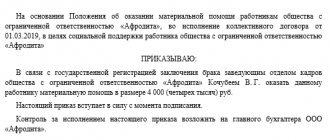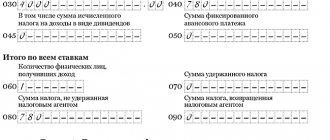The concept of financial assistance, its general characteristics and procedure for registration
Financial assistance is a monetary payment to an employee of an organization, which is made on the basis of a decision made by the management of the company due to the occurrence of an event that is associated with the need for payment.
Neither the Labor Code of the Russian Federation nor other regulations governing labor relations contain an exhaustive list of such events. Formally, financial assistance can be paid when an employee experiences any situation that the organization’s management associates with the need for payment. As a rule, provisions on the procedure and grounds for payment of financial assistance are enshrined either in local acts of the enterprise or in a collective agreement. However, this does not mean that in the absence of local regulation, the employer does not have the right to pay financial assistance, since making such payments is his prerogative. At the same time, the employer has no obligation to pay money to employees if there is no regulation of the procedure for making payments in the organization.
Financial assistance to an employee
Financial assistance to an employee is a common practice of enterprises, employers of temporary labor, and individual entrepreneurs. Subject to mandatory accounting and regulated by labor and tax laws. The source of payments is the net profit of the enterprise, so at work it is rarely paid in the first quarter or half of the year, since it is difficult to determine the profitability of the enterprise.
What payments does it apply to?
A monetary benefit to an employee at work refers to non-production payments - it is not related to the nature of the enterprise’s activities and does not depend on the quality of the employee’s performance of his job duties. It can be provided not only to current but also to former employees.
The payment can be incentive (for example, to all employees when they go on vacation) or be of a social nature (for the purchase of medicines, funeral expenses, etc.).
Regulations on financial assistance to employees
The procedure for providing financial assistance at work is regulated by a local act of the enterprise: the regulation on such payments. You can usually get acquainted with it in the accounting department. This document is adopted taking into account the requirements of the collective agreement. The trade union committee monitors the observance of employee rights. The regulations on employee benefits stipulate the amounts and terms of payments.
How to calculate
The amount of assistance provided to employees is determined by the organization itself; this is fixed in the collective agreement. There are no clear rules regarding the amount of payments in the legislation, but in practice they are calculated approximately in the following amounts:
- for funerals - in budgetary organizations it is 2 employee salaries, in private ones - it depends on the social policy of the enterprise and its financial capabilities;
- for the birth of a child (can be issued to both mother and father if they work in different organizations) - determined by the internal act of the company. It is rarely higher than 50 thousand rubles, since funds above this amount are subject to taxation;
- employee training – up to 80% of payment under the agreement for the provision of educational services;
- treatment of an employee or his family members - up to 90% of the payment for treatment. It is possible to partially allocate funds from wage funds and the trade union budget;
- improvement of living conditions - up to 65% of the cost of housing purchased or rented.
How is it paid?
Targeted financial assistance at work is paid to the recipient in the same way as the basic salary. That is, if the institution is budgetary, and the salary comes to the card, then financial assistance will be transferred according to the specified details. An individual entrepreneur is allowed to pay in cash from the amount of net income, but it must be taken into account when calculating wages.
Payment terms
There are no exact deadlines established by law. But any application is subject to the federal law “On Work with Citizens’ Appeals,” which specifies a review period of no more than a month. The office work standards establish that document flow in organizations should not exceed 3 days from the day the resolution is signed by the manager until it is received by the executor. Documents on the expenditure of funds for which payment is made must be processed within 3 days.
Taxation of financial assistance
Payments of any type in the amount of up to 4,000 rubles are not subject to personal income tax (NDFL) and insurance contributions. Amounts above this norm are subject to personal income tax at the same rate as wages - 13% + contributions to compulsory insurance funds are charged. Personal income tax on material assistance is not withheld if the amounts of targeted payments are determined as:
- funeral expenses paid to the employee or members of his family;
- medical care for employees, including retired ones;
- restoration of a home damaged by a natural disaster or terrorist attack;
- for the birth of a child, if the benefit does not exceed 50 thousand rubles.
Refusal of financial assistance
Payment of financial assistance to an employee is not an obligation, but a right of the employer and is regulated exclusively by the collective agreement and other local acts. It is advisable that the company adheres to the rules for rewarding employees. But if the organization’s expenses exceed its income, which does not allow the payment of financial assistance, or the grounds for the application are not supported by documents, the employer has the right to refuse payment on legal grounds.
How to apply for financial assistance?
The procedure for registration and payment of financial assistance to workers is not fixed at the legislative level, however, based on the general provisions of the Labor Code of the Russian Federation and other acts in the field of regulation of labor relations, we can come to the conclusion that:
- payment can be made on the basis of an application from the employee, a memo from the employee’s immediate superiors, or without such documents, based on the will of the organization’s management;
- the decision to make payments is made by the employer, i.e. an administrative act is required that expresses such a will (order, instruction);
- a clear payment procedure can be established in local documentation or a collective agreement.
Attention! Sample from ConsultantPlus See a sample of the Regulations on the payment of financial assistance to employees of the organization.
Qualitative signs of financial assistance
Having analyzed various regulations governing the payment of financial assistance, we can draw a conclusion about its main features and differences from other payments at the enterprise.
- Personalities, not positions . Financial assistance is not related to the employee’s work initiatives and successes, as well as to his failures and irregularities in work. This is not a form of employee incentives and has nothing to do with remuneration for work. Assigned to a specific person who is faced with special circumstances in life. Regardless of what position he holds.
- . ” The exclusivity of the cases in which such support is provided makes the regular nature of such payments impossible. If “material assistance” is assigned and received constantly, these payments will relate to a completely different item of the enterprise’s expenses, which will be confirmed by the very first tax audit.
- The circumstances are extraordinary! Financial assistance can be received when something unrelated to work has happened in an employee’s life, forcing him to incur unexpected financial costs. The employer's goodwill in providing assistance can support him in difficult times. These special circumstances must be confirmed in writing: a certificate, a certificate, or other documentary evidence.
- Request for help . This financial payment can only be initiated by the employee himself who needs help. The employer will consider his application with supporting documents and make a decision. It does not have to be positive, because help is voluntary.
NOTE! Even if in, this cannot oblige the employer to pay it. The “Regulations” only regulate the grounds and procedure for this payment, but the employer makes the decision on its assignment individually in each specific case.
In what cases can financial assistance be paid?
The following types of financial assistance are distinguished:
- one-time (one-time) or periodic;
- expressed in cash (rubles) or in kind, in particular medicines, things, etc.
- associated with certain events in the employee’s current activities (for example, going on another paid leave), with negatively characterized events (for example, the illness of a relative of an employee) or with positively characterized circumstances (for example, the birth of an employee’s child).
The grounds for payments include:
- employee retirement due to age;
- birth of children;
- employee's wedding;
- employee illness;
- illness of his family members;
- death of a relative;
- another paid vacation.
Since the payment procedure may differ in different organizations, and in some companies it is not fixed at all, we will next consider the most typical methods of obtaining financial assistance.
State financial assistance
The rules, amounts and lines of payments of financial assistance from the state are regulated by the norms of Federal Law No. 178-FZ “On State Social Assistance”. Issued and paid by social security authorities. It is paid to students, disabled children, pensioners, persons called up for compulsory military service, entrepreneurs for the development of subsidiary farming and other socially vulnerable segments of the population after consideration of the application and confirmation of the right to payment.
Low-income families
Payments to low-income families depend on the region of residence and the amount of monthly income of the spouses, divided among all family members. Includes amounts of wages, additional payments, and alimony. Federal law provides for amounts of assistance ranging from 500 to 3,000 rubles per family member per year. Since such an amount cannot satisfy the family's requirements, regional authorities in the region may increase the subsidy. For example, for low-income families in Moscow, the additional payment may increase to 6,000 rubles per year.
Large families
When receiving the status of a large family, parents or one of the parents are entitled to an annual payment of assistance from the state. It can be allocated both in financial form and in food, clothing, etc. For large families, special benefits for utilities are provided, payment for food services in preschool institutions, reduction in mortgage rates - all this can also be considered additional government assistance.
For single mothers
Financial assistance for single mothers depends on the mother’s income, including the presence or absence of one-time payments, such as assistance at the birth of a child from the employer. To register, it is necessary to submit to the social protection authority, in addition to the application, a certificate of income of all family members, and a certificate of assignment of single mother status. You may have to collect other documents at the request of the social security inspector. After receiving a positive decision on the appointment of financial assistance, it is paid to the applicant’s card or account.
How is financial assistance paid? Consolidation of the payment procedure in local acts of the organization
Part 2 art. 5 of the Labor Code of the Russian Federation stipulates that labor relations can be regulated in various ways, in particular, through the adoption of collective agreements, agreements or local acts. Regarding the procedure for paying financial assistance, the following options are possible:
- a collective agreement is adopted regulating the procedure for paying financial assistance;
- a local act is approved, which sets out the procedure and grounds for payments;
- this issue is generally ignored (which also does not contradict the law).
The procedure for adopting local acts is enshrined in Art. 8 Labor Code of the Russian Federation. The right to their acceptance by the employer is established by Part 1 of Art. 22 Labor Code of the Russian Federation. They may also establish the rights and obligations of the employer and workers, as follows from the provisions of Art. 20 Labor Code of the Russian Federation.
It is possible that such rights and obligations may also be established regarding the need for payment by the employer and the possibility of employees receiving amounts of financial assistance. At the same time, compliance with the local act adopted at the enterprise is mandatory for both parties to the labor relationship.
A local act is an administrative document drawn up by the employer, therefore, when adopting it, the company’s management, as a rule, focuses on its rights, but not its obligations. This is understandable, since it is unprofitable to force yourself into a framework by prescribing obligations to pay amounts of financial assistance to employers. It is much more profitable from the manager’s point of view to leave this issue vague, without fixing specific obligations, but nevertheless leaving the possibility of payments at his own discretion.
In this regard, workers who want to consolidate the procedure for paying financial assistance will achieve more effective results if they initiate a negotiation procedure with the aim of adopting a collective agreement.
How to apply for financial assistance if the organization has adopted a local act or a collective agreement?
If the payment procedure is regulated by internal documents, the algorithm for transferring financial assistance will depend on what provisions are contained in the local act or collective agreement. In all cases, the basis for payment will be the order of the employer. Let us give an example of the procedure for paying financial assistance, if it is regulated.
- Before initiating the procedure, it is determined whether there are grounds for payment.
- The procedure is initiated. The payment may be made at the initiative of the employer; at the initiative of the employee (by submitting an application to management); on the initiative of the direct management of the employee who is entitled to financial assistance (by sending a submission to the employer). Most often, financial assistance is paid based on the employee’s application.
- The employee’s compliance with the criteria specified in internal documents is checked. This procedure can be carried out by both the employer and a person authorized by him.
- An order for payment is issued if the employee is entitled to receive financial assistance, or a written refusal is prepared.
- If an order is issued, it is signed by the employer, the employee gets acquainted with it, and the document is transferred to the accounting department for execution.
Securing the procedure for paying financial assistance in a collective agreement
By virtue of Art. 40 of the Labor Code of the Russian Federation, a collective agreement is a legal act that regulates various relations within the company. It is concluded between employees and the employer, through representatives, through collective bargaining (Chapter 6 of the Labor Code of the Russian Federation).
Part 1 art. 41 of the Labor Code of the Russian Federation, which determines the content and structure of the collective agreement, does not exclude that such a document may also stipulate the employer’s obligations to pay financial assistance and the procedure for such payments.
If, when adopting a local act, the employer acts independently (in some cases, the opinion of the trade union is taken into account, by virtue of Part 2 of Article 8 of the Labor Code of the Russian Federation), then the collective agreement is adopted through active discussion of its content by representatives of both parties to the labor relationship, which implies that in such In the document, the rights of employees to receive financial assistance will be reflected in more detail. In addition, employees can independently initiate the procedure for conducting collective bargaining, and the employer does not have the right to refuse to participate in them.
It is advisable to reflect in the contract the detailed procedure and cases of payment of financial assistance, which will allow regulating these legal relations.
List of documents that may be necessary to obtain financial assistance for an employee
Since the issue of payment of financial assistance is not regulated at the legislative level, there is no mandatory package of documents that must be submitted to the employee in order to receive the payment. At the same time, collective agreements and local acts may establish such a list.
Since financial assistance is paid due to the occurrence of various events in the employee’s life, documents must confirm the fact of their occurrence. The main document is an application or memo. On their basis, the procedure for issuing financial aid is initiated.
What additional documents are required to be provided depends on the situation:
- If an employee applies for financial assistance in connection with the birth of a child, he must provide a birth certificate.
- If an employee gets sick and needs money for treatment, a doctor’s report and/or a medical commission will be required, as well as other documents confirming the presence of the disease.
- If an employee goes on vacation and therefore wants to receive financial assistance, evidence of going on vacation can be a vacation schedule or an order from the employer. Management already has these documents, so in such a situation it is advisable to submit only an application for payment.
- If a family member of an employee has died, it is necessary to provide the employer with a death certificate or a court decision recognizing the family member as deceased.
How to get financial assistance at work
To receive a sum of money at the main place of work, an employee must:
- write an application for financial assistance;
- attach documents, certificates, examinations confirming the right to receive it.
A package of documents along with the application is submitted to the clerk/secretary or directly to the manager to make a decision on the payment of funds. If the decision is positive, the documents are transferred to the accounting department for execution. In budgetary organizations, the process of transferring financial assistance is slower than private firms, since statements are transferred to the financial department, treasury, and only then to the bank.
- Pork medallions: recipes with photos
- How to do eyebrow correction at home
- Adhesive disease of the abdominal cavity - prevention and treatment. Symptoms of abdominal adhesive disease, diet
Due to difficult financial situation
When submitting an application for the provision of financial resources due to a difficult financial situation, the employee must write an application and attach documents confirming the right to receive funds:
- certificate of income of family members (if there is official employment);
- certificate of family composition;
- other documents confirming the difficult situation (for example, an act of unsuitability of housing).
For treatment
When applying for funds for the treatment of the employee himself or a member of his family, the following are provided along with the application:
- conclusion of a medical institution on the need for treatment;
- checks and receipts issued to the employee for the purchase of medicines, payment for operations and other expenses.
For the anniversary
Anniversary payments are classified as targeted assistance. Often singled out by order of the leader without the knowledge of the hero of the day. But if such an order has not been received, the hero of the day can take care of himself by submitting an application and the following documents:
- a copy of the passport (the page with the date of birth);
- petition from the immediate supervisor for assistance.
In such cases, payments to former employees are also possible (by decision of the manager and/or trade union committee).
At the birth of a child
The benefit for the birth or adoption of a child is established by a collective agreement, which specifies the amounts tied to the employee’s salary, or 50 thousand rubles. To complete it you need:
- employee statement;
- a copy of the child's birth certificate;
- a copy of the marriage certificate (if available).
For a wedding
When an employee gets married, funds are allocated according to the following documents:
- a petition from the immediate supervisor for assistance (in large organizations) or an oral request to the director;
- an application addressed to the manager for the provision of financial assistance.
Due to the death of relatives
Social benefits for funerals are negligible, so it is often impossible to do without the help of an employer. As a rule, payments from the company are issued promptly so that the employee has the opportunity to pay for funeral services. Financial assistance in connection with death is issued with the provision of documents:
- application addressed to the head of the organization;
- a copy of the death certificate, which is issued by the registry office after receiving a medical certificate at the hospital (morgue).
Application for financial assistance and its sample, memo (memorandum)
In order for the employer to learn that an event has occurred in the employee’s life that may serve as a basis for payment of financial assistance, the employee needs to notify him about it. Notification is made on the basis of an application.
The application form is not fixed by law, but can be provided in a local act or collective agreement. The legislation also does not contain any requirements for the application.
A sample of such a document might look like this:
To the Director of Iris LLC
Petrov T.N.
From senior manager
Karpova T. G.
Statement
I ask you to provide me with financial assistance in the amount of 5,000 rubles. due to the need to purchase medications to treat detected kidney disease.
Attachment: a copy of the conclusion of the medical commission of the BUZ "Moscow City Clinic" dated 07/12/2020 No. 127-ZK, a copy of the prescription dated 07/12/2020 No. 129571, issued by doctor R.V. Anisimova.
07/12/2020 Karpov T. G. /Karpov/
The application is submitted in 2 copies. One copy is marked with the date of delivery and the signature of the person to whom the application was transferred, and the second copy is transferred to the employer.
The second way to notify the employer of the occurrence of a certain event related to the need to pay financial assistance is a memo, drawn up, for example, by the employee’s immediate supervisor.
A sample memo might look like this:
To the Director of Iris LLC
Petrov T.N.
From the head of the sales department
Ignatieva T.V.
Service memo
I would like to bring to your attention that on July 12, 2020, senior manager Karpov T.G. gave birth to a child - a daughter, Karpova V.T. I ask you to consider the possibility of providing Karpov T.G. with financial assistance in the amount of 5,000 rubles.
Ignatiev T.V. /Ignatiev/ 07/12/2020
Application for financial assistance in connection with the death of a relative
The grief that comes to a family not only has an emotional impact on all relatives, but also, as a rule, makes a significant hole in the budget. The employer, taking care of the staff, can help the bereaved employee a little financially. In this case, the funds are paid from the organization’s profit fund; these expenses have tax benefits.
To do this, the organization’s local regulations must stipulate this possibility and its regulations. For this purpose, a special Regulation may be created or the relevant information should be contained in the employment contract or collective agreement. Usually, not only the employee who has lost a loved one has the right to such a payment, but also, conversely, his relatives if the employee himself has died.
The first document required for the accrual of this type of financial assistance is the employee’s request, drawn up in the form of an application. In addition to the request for one-time financial support, the text must indicate:
- Full name of the manager (general director);
- all employee data (position and full name);
- degree of relationship with the deceased (close relatives in connection with whose death financial assistance is provided are brothers and sisters, children or parents of the employee);
- you can indicate the amount that the employer is asking for (it cannot be more than two months’ salary);
- a list of documents confirming relationship and death attached to the application;
- date, painting with transcript.
ATTENTION! It does not matter whether the amount of assistance is indicated in the application; in any case, the manager enters it into the Order, on the basis of which it will be calculated.
Sample application for financial assistance in connection with the death of a relative
To the General Director of Zarathustra LLC, Nikipelov Roman Olegovich, from the manager of the supply department, Anatoly Petrovich Rostovsky
STATEMENT
I ask you to provide me with financial assistance in connection with the death of a close relative - Rostovsky’s brother Mikhail Petrovich.
I am attaching to the application:
- certificate of family composition;
- death certificate of Rostovsky M.P.
06.20.2017 /Rostovsky/ A.P. Rostovsky
Is it possible to receive financial assistance without documents?
Receiving financial assistance without documents is possible only if the decision is made by the employer on his own initiative. If the initiator of the request for the transfer of financial assistance amounts is an employee, the application is a mandatory document. In the event that an employee’s immediate superior requests payment of financial assistance, an official memo is a mandatory document.
The decision to issue financial assistance can be made by the employer without documents proving the occurrence of a particular event in the employee’s life. Their presence, as a general rule, is not necessary (unless otherwise stated in a local act or collective agreement). At the same time, the employer may refuse payment due to the lack of proof of the occurrence in the employee’s life of an event that is cited as the basis for payment of financial assistance.
Sample order for provision of financial assistance
Payment of financial assistance is made on the basis of an order from the employer. Its form is not fixed by law. At the same time, it can be determined by the provisions of a local act or a collective agreement.
The order can be issued in the following format:
LLC "Iris"
Moscow
ORDER
About payment of financial assistance
07/12/2020 No. 124-ls
In connection with the illness of the chief manager of the operating department of Iris LLC, Irakov R.V., confirmed by the documents submitted by him (copy of the conclusion of the medical commission of the Moscow City Clinic dated July 12, 2020 No. 127-ZK, copy of the prescription dated July 12, 2020 No. 129571 ),
I ORDER:
Pay Irakov R.V. financial assistance in the amount of 5,000 rubles.
The payment of financial aid should be made together with the payment of the next salary for August 2021.
Reason: application of R.V. Irakov dated July 12, 2020, copy of the conclusion of the medical commission of the Moscow City Clinic dated July 12, 2020 No. 127-ZK, copy of the prescription dated July 12, 2020 No. 129571
Director of Iris LLC Vasiliev O.V. /Vasiliev/
Sources of payment
The payment can be made from the wage fund, from current profits or profits from previous years. If a decision is made to make a payment from the wage fund, it is imperative to reflect the possibility of financial assistance in the labor and/or collective agreement.
It would be better if this was a provision on the procedure for issuing financial assistance. In case of its absence, an additional agreement to the employment contract .
In order to make a payment from the profits of previous years, a protocol of the decision of the general meeting of shareholders (for a JSC) or participants (in the case of an LLC) . Even if the organization has one shareholder (participant), a written decision is mandatory.
Purpose of payment when paying out financial assistance
When transferring amounts of financial assistance, you must indicate the purpose of the payment in the payment order. In addition, you should refer to information about the order on the basis of which the amount is paid.
For example, the column “Purpose of payment” can be filled in as follows: financial assistance to A. A. Ivanov in connection with the birth of a child, paid on the basis of the order of the director of Iris LLC dated July 12, 2020 No. 1.
The need to indicate the correct purpose of the payment is also related to taxation. Some types of financial assistance, in accordance with Art. 217 of the Tax Code of the Russian Federation are not taxed. The purpose of the payment will serve as proof that the money was spent specifically on the payment of financial assistance.
Important! Hint from ConsultantPlus Types of financial assistance that are partially (in the deduction amount) or completely exempt from personal income tax, and the grounds for such exemption are given in Art. 217 Tax Code of the Russian Federation. For a complete list of such payments, as well as cases and procedures for paying personal income tax on financial assistance, see K+.
What is financial assistance
According to the dictionary of terms of regulatory and technical documentation, one-time financial assistance is a socio-economic service provided in cash, products, care products, clothing and other current assets. In accounting terms, payment to an employee of an enterprise in money or goods (services) that can be determined in a calculable monetary equivalent.
The basic rule with which the concept of financial assistance is associated is that the recipient’s income must be below the subsistence level in a certain area. In this case, the income of all family members is taken into account. If a family plans to apply for financial assistance from the state, then it is impossible to do without certificates of family composition and income from work (2NDFL). Moreover, it may well turn out that they will have to be updated more than once.
Who is entitled to
The state is trying to provide maximum social support for its citizens by establishing new lists of payments, benefits and benefits. For example, the following may apply for financial assistance to official bodies:
- low-income people – after receiving the appropriate status;
- large families, if the total income level does not exceed the permissible standard of living in the region of residence on the day of application;
- citizens affected by natural disasters;
- single mothers;
- pensioners;
- disabled people.
This list is incomplete. These categories of citizens can write applications for payment annually. In addition to the indicated categories of persons, any citizens in certain situations are entitled to receive lump-sum payments of funds, including those who are able to work, for example, those who have incurred funeral expenses (financial assistance in connection with death is paid within six months from the date of death).
In addition to state protection, any employee with whom an employment contract has been concluded can write an application for benefits addressed to the employer. And although the law does not directly oblige the employer to make such payments, in practice they exist in the vast majority of organizations.
The form, procedure and amounts are established by managers in accordance with the collective agreement of the enterprise on the basis of the Labor Code of the Russian Federation. The difference between different types of assistance is important for determining the amount of personal income tax (NDFL), which is withheld by the accountant when calculating.
Who pays
State benefits are paid by social protection authorities based on the results of consideration of the application and documents confirming the right to receive. Benefits from the employer are paid by the accounting department at the place of official employment. In some cases, compensation of various kinds is received by an employee who retired (went on maternity leave) on holidays or significant dates, then payment comes from the trade union committee.
Types of financial assistance
Financial assistance can be classified by type:
- targeted - must be confirmed by documents, paid by order of the manager (illness, death of a relative, birth of a child, material damage, etc.). This type also includes compensation for employee expenses incurred in connection with the performance of official duties;
- non-targeted - in the documents the purpose of use is not specifically stated (for example, the difficult financial situation of an employee without specifying the reason);
- one-time – paid once in connection with specific circumstances;
- periodic, or permanent - paid annually (or at certain intervals) until the elimination of circumstances affecting the level of income of a person or family.
Results
Thus, the answer to the question of how to arrange financial assistance for employees may be different.
This is due to the fact that depending on the local documentation adopted by the organization, the procedure for processing payments may vary. At the same time, in all cases, payment is made on the basis of the employer’s order. You can find more complete information on the topic in ConsultantPlus. Free trial access to the system for 2 days.








